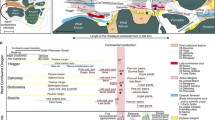Abstract
Although non-collisional mountain belts, such as the Andes, and collisional mountain belts, such as the Alps and the Himalayas–Tibet, have been regarded as fundamentally different, the Central Andes share several features with the Himalayas–Tibet. The most important of these are extremely thickened (≥70 km) continental crustal roots supporting high plateaus and mountain fronts characterized by large basement thrusts. The main prerequisite for very thick crustal roots and extreme mountainous topography appears to be large-scale underthrusting of continental crust of normal thickness, irrespective of whether the crustal thrusts are antithetic with respect to subduction as in the Andes, or synthetic with respect to preceding subduction of oceanic lithosphere as in the Himalayas. In both cases sole thrusts near the base of the continental crust nucleated in thermally anomalous zones of the hinterland and then propagated across ramps into shallower detachments located within thick sedimentary or metasedimentary cover rocks. In contrast to the Central Andes and the Himalayas, the Alps are characterized by intracrustal detachment which allowed both the subduction of lower crust and a stacking of relatively thin upper crustal slivers, which make up a narrow mountain chain with a more subdued topography.
Similar content being viewed by others
Author information
Authors and Affiliations
Additional information
Received: 10 August 1998 / Accepted: 1 March 1999
Rights and permissions
About this article
Cite this article
Kley, J., Eisbacher, G. How Alpine or Himalayan are the Central Andes?. Int Journ Earth Sciences 88, 175–189 (1999). https://doi.org/10.1007/s005310050258
Issue Date:
DOI: https://doi.org/10.1007/s005310050258




